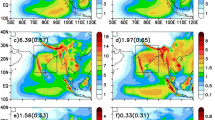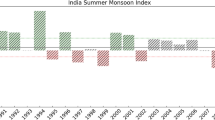Abstract
Indian summer monsoon circulation can be characterized by mean tropospheric temperature (TT) gradient between ocean and land. Two major heat sources, one near the Myanmar Coast and the other near the Western Ghats play seminal role in defining this TT gradient. While both regions are characterized by very similar orographic features, there are significant differences in frequency of occurrence of precipitating clouds and their characteristics even when the amount of rain in June–July months is almost same in the two regions. Deeper (shallower) clouds appear more frequently over the Myanmar Coast (the Western Ghats). There is a sharp decrease in amount of rainfall from June–July to August–September in both the areas. Rather counter intuitively, during the June–July–August–September season, low and moderate rains contribute more to the total rain in the Myanmar Coast while heavy rains contribute more to the total rain in the Western Ghats. Western Ghats also gets more intense rains but less frequently. With significant differences in moisture availability, updraft, amount and characteristics of cloud condensate in the two regions, this study proposes that the nontrivial differences in features between them could be explained by linkages between cloud microphysics and large scale dynamics. Presence of more cloud liquid water and the role of giant cloud condensation nuclei reveals dominance of warm rain process in the Western Ghats whereas more cloud ice, snow and graupel formation in the Myanmar Coast indicates stronger possibility of cold rain coming from mixed phase processes. Stronger heating caused by mixed phase process in the mid and upper troposphere in the Myanmar Coast and its feedback on buoyancy of air parcel explains the appearance of deeper clouds. Thus, our study highlights importance of mixed phase processes, a major cause of uncertainty in GCMs.












Similar content being viewed by others
References
Albrecht BA (1989) Aerosols, cloud microphysics and fractional cloudiness. Science 245:1227–1230. doi:10.1126/science.245.4923.1227
Cess RD et al (1990) Intercomparison and interpretation of climate feedback processes in 19 atmospheric general circulation models. J Geophys Res 95:16601–16615
Chattopadhyay R, Goswami BN, Sahai AK, Fraedrich K (2009) Role of stratiform rainfall in modifying the northward propagation of monsoon intraseasonal oscillation. J Geophys Res 114:D19114. doi:10.1029/2009JD011869
Cheng C-T, Wang W-C, Chen J-P (2007) A modeling study of aerosol impacts on cloud microphysics and radiative properties. Quart J Roy Meteor Soc 133:283–297
Cheng C-T, Wang W-C, Chen J-P (2010) Simulation of the effects of increasing cloud condensation nuclei on mixed-phase clouds and precipitation of a front system. Atmos Res 96:461–476
Gadgil S, Sajani S (1998) Monsoon precipitation in the AMIP runs. Clim Dyn 14:659–689
Goswami BN (1998) Interannual variation of Indian summer monsoon in a GCM: external conditions versus internal feedbacks. J Clim 11:501–522
Goswami BN, Ajaya Mohan RS (2001) Intra-seasonal oscillations and inter-annual variability of the Indian summer monsoon. J Clim 14:1180–1198
Goswami BN, Wu G, Yasunari T (2006) Annual cycle, intraseasonal oscillations and roadblock to seasonal predictability of the Asian summer monsoon. J Clim 19:5078–5099
Houze RA, Jr (2012) Orographic effects on precipitating clouds. Rev Geophys 50:RG1001. doi:10.1029/2011RG000365
Kang I-S, Shukla J (2006) Dynamic seasonal prediction and predictability of the monsoon. In: B Wang (ed) The Asian monsoon, Ch. 15. Springer/Praxis Publishing Co., New York
Kaufman YJ, Tanré D (1998) Algorithm for remote sensing of tropospheric aerosol from MODIS. NASA MODIS Algorithm Theoretical Basis Document, Goddard Space Flight Center 85
Kaufman YJ, Tanre D, Remer LA, Vermote EF, Chu A, Holben BN (1997) Operational remote sensing of tropospheric aerosol over land from EOS moderate resolution imaging spectroradiometer. J Geophys Res 102:17051–17067
Khain AP, Phillips V, Benmoshe N, Pokrovsky A (2012) The role of small soluble aerosols in the microphysics of deep maritime clouds. J Atmos Sci 69:2787–2807
Konwar M, Maheshkumar RS, Kulkarni JR, Padmakumari B, Morwal SB, Deshpande CG, Axisa D, Burger R, Piketh S, Rosenfeld D, Goswami BN (2012) Contrasting polluted and pristine cloud microphysical properties over the Arabian Sea and Bay of Bengal. International conference on OCHAMP-2012, OC-000112
Kummerow C, Hong Y, Olson WS, Yang S, Adler RF, McCollum J, Ferraro R, Petty G, Shin DB, Wilheit TT (2001) The evolution of the Goddard profiling algorithm (GPROF) for rainfall estimation from passive microwave sensors. J Appl Meteor 40:1801–1840
Meneghini R et al (1998) Estimates of path attenuation for the TRMM radar. Geoscience and remote sensing symposium proceedings. IGARSS’98, IEEE International, 4 IEEE
Meneghini R, Jones JA (1993) An approach to estimate the areal rain-rate distribution from spaceborne radar by the use of multiple thresholds. J Appl Meteorol 32:386–398
Parthasarathy B, Munot AA, Kothawale DR (1994) All India monthly and seasonal rainfall series: 1871–1993. Theor Appl Climtol 49:217–224
Pokhrel S, Sikka DR (2012) Variability of the TRMM-PR total and convective and stratiform rain fractions over the Indian region during the summer monsoon. Clim Dyn. doi:10.1007/s00382-012-1502-1
Pruppacher HR, Klett JD (1997) Microphysics of clouds and precipitation. Kluwer Acad, Norwell
Rajeevan M, Srinivasan J (2000) Net cloud radiative forcing at the top of the atmosphere in the Asian monsoon region. J Clim 13(3):650–657
Rajeevan M, Rohini P, Niranjan Kumar K, Srinivasan J, Unnikrishnan CK (2012) A study of vertical cloud structure of the Indian summer monsoon using CloudSat data. Clim Dyn. doi:10.1007/s00382-012-1374-4
Rienecker MM et al (2011) MERRA: NASA’s modern-era retrospective analysis for research and applications. J Clim 24:3624–3648. doi:10.1175/JCLI-D-11-00015.1
Romatschke Ulrike, Houze Robert A Jr (2011) Characteristics of precipitating convective systems in the South Asian monsoon. J Hydrometeorol 12(1):3–26
Rosenfeld D (1999) TRMM observed first direct evidence of smoke from forest fires inhibiting rainfall. Geophy Res Lett 26:3105–3108. doi:10.1029/1999GL006066
Satheesh SK, Krishnamoorthy K (1997) Aerosol characteristics over coastal regions of the Arabian Sea. Tellus 49B:417–428
Satheesh SK, Krishnamoorthy K, Das I (2001) Aerosol spectral optical depths over the Bay of Bengal, Arabian Sea and Indian Ocean. Curr Sci 81:1617–1625
Slingo A (1987) The development and verification of cloud prediction scheme for the ECMWF model. Q J Roy Meteorol Soc 113:899–927
Sperber KR, Palmer TN (1996) Interannual tropical variability in general circulation model simulations associated with the atmospheric model intercomparison project. J Clim 9:2727–2750
Sperber KR, Brankovic C, Deque M, Frederiksen CS, Graham R, Kitoh A, Kobayashi C, Palmer T, Puri K, Tennant W, Volodin E (2001) Dynamical seasonal predictability of the Asian summer monsoon. Mon Weather Rev 129:2226–2248
Sperber KR, Annamalai H, Kang I-S, Kitoh A, Moise A, Turner A, Wang B, Zhou T (2012) The Asian summer monsoon: an intercomparison of CMIP5 vs. CMIP3 simulations of the late 20th century. Clim Dyn. doi:10.1007/s00382-012-1607-6
Squires P, Twomey S (1961) The relation between cloud drop numbers and the spectrum of cloud nuclei. Phys Precip. Monograph, no. 5, pp 211–219, AGU, Washington, DC
Tao WK, Lang S, Olson WS, Meneghini R, Yang S, Simpson J, Kummerow C, Smith E, Halverson J (2001) Retrieved vertical profiles of latent heat release using TRMM rainfall products for february 1998. J Appl Meteorol 40:957–982
Tao W-K, Smith EA, Adler R, Haddad Z, Hou A, Kakar R, Krishnamurti T, Kummerow C, Lang S, Meneghini R, Olson W, Satoh S, Shige S, Simpson J, Takayabu Y, Tripoli G, Yang S (2006) Retrieval of latent heating from TRMM measurements. Bull Amer Meteor Soc 87:1555–1572
Tao W-K, Chen J-P, Li Z, Wang C, Zhang C (2012) Impact of aerosols on convective clouds and precipitation. Rev Geophys 50:RG2001. doi:10.1029/2011RG000369
Twomey S (1977) The influence of pollution on the shortwave albedo of clouds. J Atmos Sci 34:1149–1152
Twomey S, Piepgrass AM, Wolfe TL (1984) An assessment of the impact of pollution on global cloud albedo. Tellus 36B:356–366
Walcek CJ, Stockwell WR, Chang JS (1990) Theoretical estimates of the dynamic, radiative, and chemical effects of clouds on tropospheric trace gases. Atmos Res 25:53–69
Wang B, Ding Q, Fu X, Kang I-S, Jin K, Shukla J, Doblas-Reyes F (2005) Fundamental challenges in simulation and prediction of summer monsoon rainfall. Geophys Res Lett 32:L15711. doi:10.1029/2005GL02273412
Warner J (1968) A reduction in rainfall associated with smoke from sugar-cane fires: an inadvertent weather modification? J Appl Meteor 7:247–251
Warner J, Twomey S (1967) The production of cloud nuclei by cane fires and the effects on cloud droplet concentration. J Atmos Sci 24:704–706
Webster PJ, Magaña VO, Palmer TN, Shukla J, Tomas RA, Yanai M, Yasunari T (1998) Monsoons: processes, predictability, and the prospects for prediction. J Geophys Res 103:14451–14510
Xie S-P, Xu H, Saji NH, Wang Y (2006) Role of narrow mountains in large-scale organization of Asian monsoon convection. J Clim 19:3420–3429
Zhou YP, Tao W-K, Hou AY, Olson WS, Shie C-L, Lau K-M, Chou M-D, Lin X, Grecu M (2007) Use of high-resolution satellite observations to evaluate cloud and precipitation statistics from cloud-resolving model simulations. Part I: South China Sea monsoon experiment. J Atmos Sci 64:4309–4329
Acknowledgments
Indian Institute of Tropical Meteorology (IITM), Pune, is fully funded by the Ministry of Earth Sciences, Government of India, New Delhi. Authors duly acknowledge NASA for the data sets TRMM, AIRS, MERRA etc. We also acknowledge the MODIS mission scientists and associated NASA personnel for the production of the data used in this research effort. Some data used in this study were produced with the Giovanni online data system, developed and maintained by the NASA GES DISC. Authors duly acknowledge Dr. X. Jiang of JPL, NASA for providing CloudSat data. Authors also sincerely thank Mr. M. Mahakur for providing OLR data from Kalpana Satellite and Mr. V. Sasane for helping in drawing the Schematic Diagram.
Author information
Authors and Affiliations
Corresponding author
Rights and permissions
About this article
Cite this article
Kumar, S., Hazra, A. & Goswami, B.N. Role of interaction between dynamics, thermodynamics and cloud microphysics on summer monsoon precipitating clouds over the Myanmar Coast and the Western Ghats. Clim Dyn 43, 911–924 (2014). https://doi.org/10.1007/s00382-013-1909-3
Received:
Accepted:
Published:
Issue Date:
DOI: https://doi.org/10.1007/s00382-013-1909-3




